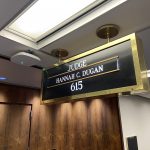MSO aglow with Haydn, Ives, Wagner
Conductor Francesco Lecco-Chong and a reduced MSO make the music work under the dome of the Basilica of St. Josaphat.
MSO Associate Conductor Francesco Lecce-Chong, determined to establish St. Josephat Basilica as a location of choice, not necessity, presented the second of a series of carefully designed Milwaukee Symphony programs Friday evening on the South Side. In his program notes, Lecce-Chong described his choices of “three important works that ask for our contemplation of the message.”
The evening featured Joseph Haydn’s hour-long Seven Last Words of Christ. Originally for orchestra alone, the work is more familiar as a choral work with a larger orchestra and is frequently played as a meditative work for string quartet. Lecce-Chong performed the original, complete with a reader, Friar Paul Langevin. He spoke the phrases, in both Latin and English, that are the basis for each section.
Haydn built many sections upon a pulsing backdrop from one or several string sections beneath a theme or motif from the other strings, joined by winds at climatic moments. Oboe and flute carry the story in this programmatic work.
Lecce-Chong was able to control the acoustical effects in more robust sections by extending rests long enough to let the echoes dissolve in the Basilica space. String sections were restrained. The pace was glacial at times, in keeping with Haydn’s intentions for a contemplative work.
The drama is low-key. Even the angst of “My God, my God why have you forsaken me?” plays out in a firm but undramatic descending pulse to bring the music to a quiet conclusion.The fifth section – “I thirst” – featured wind motifs expressed above a tender, light staccato treatment in cello and bass sections. The seventh section – “Father, into your hands I commend my spirit” – became increasingly bright. As the full orchestra joined in choral sections, the oboe sang joyfully. Other winds, then french horns, joined in the triumphant mood.
Haydn ends the work, as Christ dies, with an earthquake. Trumpets and timpani, silent until this section, are unloosed. Lecce-Chong urged a frenetic response from the entire orchestra as a cacophony, appropriately amplified and layered by the echoes within the vast basilica dome, shattered serenity.
(An excellent video performance of Seven Last Words with Jordi Savall conducting Le Concert des Nations in the Spanish church which hosted the premier event can be found here. Lecce-Chong and Savalli share a respect for a quiet, contemplative interpretation of this work.)
A reduced orchestra presented The Unanswered Question by Charles Ives, a short work in three layers. A full string section repeated a drawn-out, delicate harmonious theme. The strings, barely audible at times, allowed the acoustic to retain and carry the sound. A single trumpet broke the mood with a single phrase – a question. A quartet of winds responded conversationally. The repeated question from the trumpet, less tentative, was met with an increasingly dissonant response from the wind quartet. In this performance, the annoyed attitude of the quartet was clear as a rapid, dissonant commentary. The seventh entry of the trumpet elicited no response. The strings faded away as silently as they had entered.
What is there to contemplate in Ives’ composition? Perhaps the many times this enigmatic work has been performed, set for all time with no resolution. It remains a brief, magical experience.
The evening concluded with Richard Wagner’s Prelude and “Liebestod” from Tristan and Isolde. Wagner here distilled the essence of a four hour-opera. Even condensed to twenty minutes, the work advances slowly – love between the protagonists grows, they contemplate the fate that separates them. Isolde, in a bright, affirming statement, declares her love even with Tristan’s death. The intended contemplation? Love can be transformed in death.
Lecce-Chong drew out the atmosphere of this work with restrained but sustained lines in the strings and a pacing that ebbed and flowed as though long waves lapping on the beach. The pace increased imperceptibly throughout. Wagner also builds energy by gradually adding winds, harp, brass and timpani. Only at the crescendo of these episodes did the hall return a screech from three flutes. The atmosphere was stirring, romantic and affirming, but until the Liebestod section it was not clear how morose the mood had been. The sun came out, the bright optimism of the “love in death” commitment by Isolde transformed the music and the visceral response in the listener. Lecce-Chong managed the arch of the work well.
In the extraordinary acoustic of the Basilica, choices of music and direction bring the music under control: a slow, steady pace, unison or harmonic strings, chord transitions that reinforce each other, pauses that let the music breathe and fade away and momentum built not by volume, but by gradual changes of pace.
This concert will be repeated Saturday evening, April 13, at 7:30 p.m. Call 414 291-7605 or visit the MSO website for tickets and further information.
Lecce-Chong will conduct the third in this series of Basilica concerts May 17-18. The theme will be Remembrance.





















I ushered and stayed for the concert. Maestro Lecce-Chong does understand the sound in the basilica. Nothing was blured. I had never heard the Haydn or the Ives… what great selections for the basilica. Of course I would have loved MORE WAGNER…maybe another time.